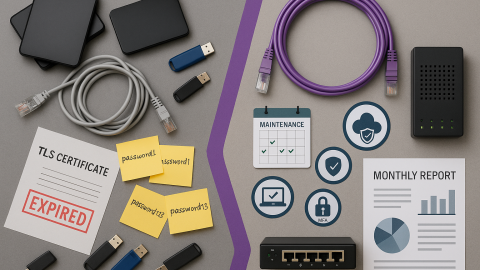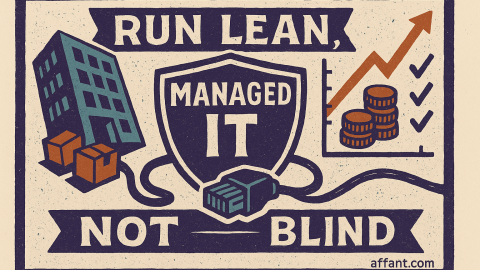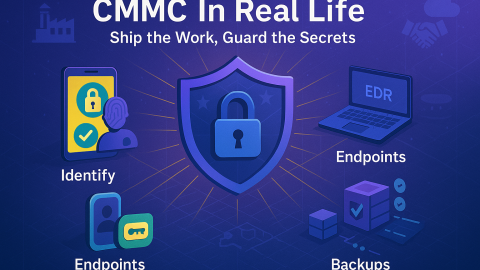Introduction
If you run a small or mid-sized business, “downtime” probably conjures images of a smoking server or a region-wide cloud outage. In reality, most damage arrives as short, silent glitches: a five-minute ISP hiccup that drops half a morning’s sales calls, or a brief spike on the firewall that corrupts the nightly backup just enough to go unnoticed—until you need it. These micro-events rarely trigger service-level agreements, yet they chip away at revenue and employee trust all the same. The cure is not more heroics from an already stretched IT team but a service that watches the network every minute of every day and intervenes before people feel pain.
The Hidden Tax of Reactive IT
Break-fix support is a little like driving without a fuel gauge: you don’t realize you are out of gas until the engine sputters. Every help-desk ticket that starts with “I got kicked out again” masks the minutes or hours employees spend retrying logins, re-entering data, or waiting for files to sync. Multiply those interruptions across dozens of staff and the cost quickly eclipses the price of a proactive monitoring subscription. Worse, because the losses appear as small pockets of wasted time rather than a single dramatic failure, they seldom show up in a quarterly report—yet the business feels the drag every day.
Inside 24 × 7 Network Monitoring
Always-on monitoring begins with a stream of telemetry—SNMP counters from switches, flow data from firewalls, API calls to cloud dashboards, and synthetic probes that mimic real users. A staffed Network Operations Center ingests that raw feed and learns the network’s heartbeat: which sites sit quiet overnight, how long backups typically run, what normal SaaS latency looks like. When a metric drifts beyond those baselines, automation acts first—maybe by failing over an SD-WAN tunnel or restarting a stuck service—while an engineer investigates root cause. A parallel Security Operations team reviews endpoint and cloud logs for ransomware behaviour, isolating any infected device in seconds. The net result is that incidents are detected within a couple of minutes and usually resolved before the first employee even reaches for the phone.
Break-Fix versus a Managed NOC, Revisited
A reactive model is cheaper only on paper. It postpones spending until something breaks, then pays in overtime, emergency call-outs, and angry customer emails. By contrast, a managed NOC turns those spikes into a predictable operating expense. It also brings discipline: every incident is documented, analysed, and folded into a preventive plan so the same alarm does not repeat next month. Over time the number of user-reported issues falls, mean time to recovery shrinks, and IT staff can focus on improvements rather than firefighting.
Compliance and Cyber-Insurance Pressures
Regulatory bodies and insurers have noticed that companies without real-time visibility suffer larger breaches and pay bigger claims. New policy applications routinely ask for proof of log aggregation, round-the-clock alert review, and measured response times. Businesses that answer “yes” with evidence see smaller premium hikes and fewer coverage exclusions. Those that cannot often face double-digit increases or ransomware payouts capped below their real exposure. Continuous monitoring, therefore, is no longer just best practice—it is the cost of remaining insurable.
A Real-World Turnaround
One regional e-commerce firm came to Affant after a string of short outages had driven an estimated forty-two-thousand dollars in lost checkout revenue. Ten days after onboarding, traffic baselines were set and automated responses were active. Within ninety days, unplanned downtime dropped from fourteen hours a year to less than two, user tickets almost halved, and the company’s cyber-insurance renewal landed at a single-digit increase instead of the threatened forty-percent jump. No additional headcount was hired in the process.
What Onboarding Looks Like
The rollout is purposefully lightweight. A discovery call identifies which devices and cloud services require coverage. Read-only credentials are generated so the monitoring platform can collect metrics without disrupting production. For about a week the system studies traffic patterns in “learning” mode, after which Affant works with the client to write a runbook that defines exactly how far the NOC can go before waking an on-call manager. Most organisations spend fewer than five internal hours spread over two weeks and emerge with full 24 × 7 visibility.
Cost and Long-Term Return
When you compare five years of numbers—including emergency labour, productivity losses, hardware failures that could have been predicted, and cyber-insurance penalties—a proactive monitoring subscription typically costs forty percent less than staying reactive. It also converts spiky, unpredictable expenses into a single line item that finance can budget around, freeing cash and attention for strategic projects instead of surprise invoices.
Quick Wins You Can Start This Week
Even if a managed NOC is still on your horizon, you can take immediate steps: forward firewall logs to a central collector, run an hourly speed-test script to catch ISP jitter, and audit TLS certificates for expiration dates hiding inside legacy servers. Each action surfaces silent risks and builds the case—often with hard numbers—for why continuous monitoring matters.
Final Word
Networks never sleep and threats never wait, so someone—either your employees or your monitoring partner—will be awake at 2 a.m. The choice is whether those after-hours alerts land in an empty inbox or a staffed operations centre ready to act. If uninterrupted uptime and calmer mornings sound appealing, Affant is ready to take the night shift and let your business grow without hidden taxes on its productivity.










